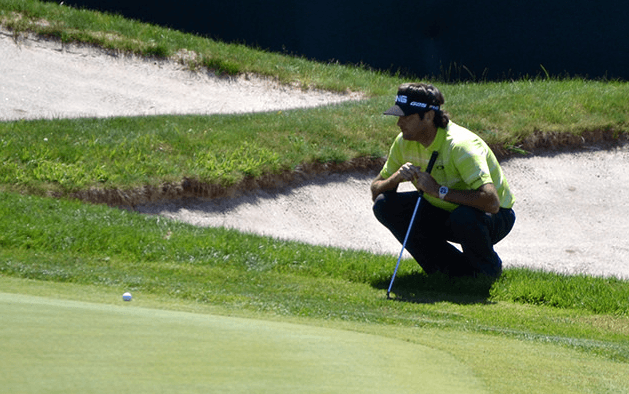
7 Tips For Better Green Reading and Immediately Lower Putts Per Round
“I never missed a putt in my mind.” – Jack Nicklaus.
Putting makes up around 33% of our scores on average, so EVERY putt is very important. We can’t afford to lose any shots to poor green reading. Thankfully, with some very simple techniques from my Tour caddie friends, getting better at green reading is an easy way to drop a few shots almost immediately. Use these 7 keys to Better Green Reading next time you’re on the course and I guarantee you’ll see improvement.
1. Where is the low point(s)? Find the big slopes
All putting greens are designed so that water will run off them. The first thing to do is figure out where this direction is. To do this you want to look for the lowest point on the green – unless it’s a 2 tier green, all putts will break to this point. As you approach the green, imagine a large bucket of water being poured on the green and visualize where it would run off and you’ll notice the big slopes.
2. Walk around the putt
It’s easy to get sloppy and just look at the putt from behind the hole. Use the time while your playing partners are putting wisely, and see as much about the putt as you can by walking around it a couple of times. While you do this:
Be aware of your feet
Walk around the putt and notice what your feet tell you. All the top players and caddies do this. To maintain an upright walking position, your feet are making adjustments, which if you pay attention to, can tell you a lot about the break of the putt. Do you feel like you’re walking up or downhill? Or on a side-slope?
Use your knees
Instead of using the standard Aimpoint technique of finding the relative pressure on your feet, I find it easier to use my knees. Straddle the line of the putt and feel which knee is further forward. If one knee is further forward, then this is the high side. The more bent one knee is vs the other, the more slope there is.
Use your eyes to look at the putt from all angles
While you’re walking around the putt, notice whether you’re higher or lower than the line from the ball to the hole? If you feel lower and you’re on the right side of the putt, then you’re looking at a left to right breaking putt.
3. Go to school on your playing partners’ putts
If you’re playing in a 4 ball, you’ll have 3 or more opportunities to get valuable information on the slopes on the green. Watch those putts very closely.
4. Feel that putt
Your line will be a factor of how hard you’re going to hit the putt, so start to feel the pace with your practice strokes and figure out whether you want to die it into the hole or hit it firm. The slower the pace, the more break the putt will take. Develop a really good pre-putt routine. See and feel the ball following its line to the hole.
5. Pick your spot
Once you’ve decided on your line, pick a spot you want the ball to roll over in the first foot of the putt. Stand behind the ball and find your spot (a blade of grass or discoloration on the green). Play a little more break than you think – most amateurs miss putts on the low side, so err on the side that tilts towards the hole.
6. Break a long putt into smaller putts
Putts of 12ft and over should be thought of as at least 2 putts. Pay special attention to finding the straight putt into the hole in the last 3 feet, which will tell you where you the angle you need the ball to come in from.
7. Read the green from 100 yards and in
To take it even further, green reading really needs to start from any distance 100 yards and in. E.g. If the green slopes back to front then you want the shot that lands the ball below the hole so you get an uphill putt that you can be aggressive with vs a downhill putt you’d have to be tentative with.
Follow these steps and you will see improvement in your putting. Whatever you decide the line is before you hit the putt, commit to it! This way you’ll put a good stroke on it instead of being tentative.



Great advice! I have been doing most of what you recommended for many years, but recently the subtle breaks are adding 6 +/- strokes per round. All the indicators indicate let’s say 3in left to right in 12 feet. Putt starts out on track then breaks a couple inches to the LEFT near the hole. I look at the line again and still don’t see the very slight left break at the end. Ideas?
Hi Dave!
Thanks for the comment! A putt of 12ft is about the length you want to start breaking up into shorter putts, with the last 3 ft being the most important. When you’re reading the green, take a really good look at that last 3 ft and imagine it’s its own putt. Looking a lot more closely at this, should enable you to see the break. Let me know how it goes!
David
nice article. you have one mistake in here….grain does not grow towards the sun, it only grows downhill.
There are times when I read a putt from behind the ball is see left to right, but from behind the hole I also see left to right. That is quite confusing.
I find that very the opposite slope very confusing